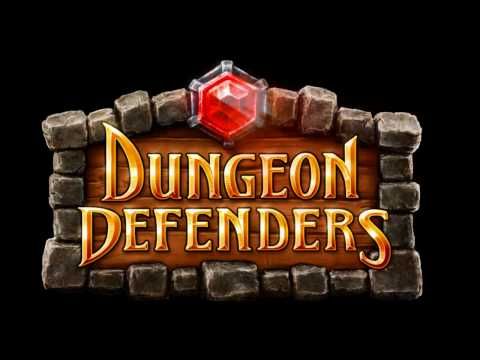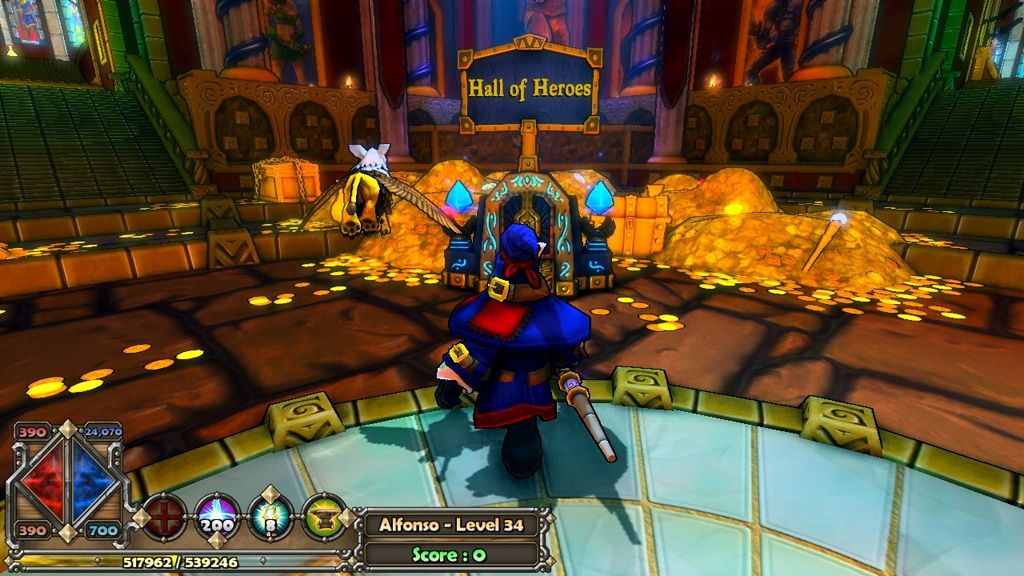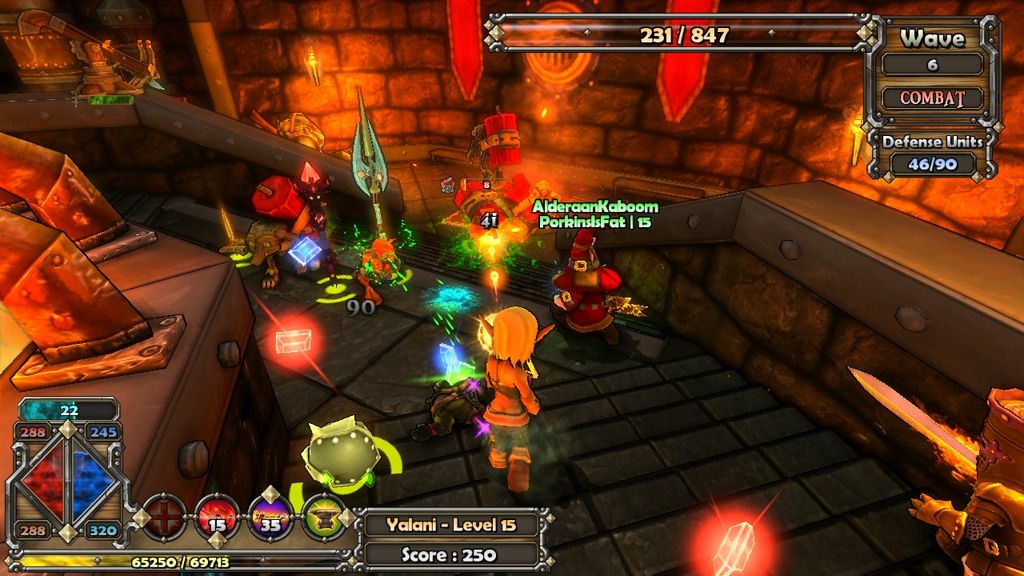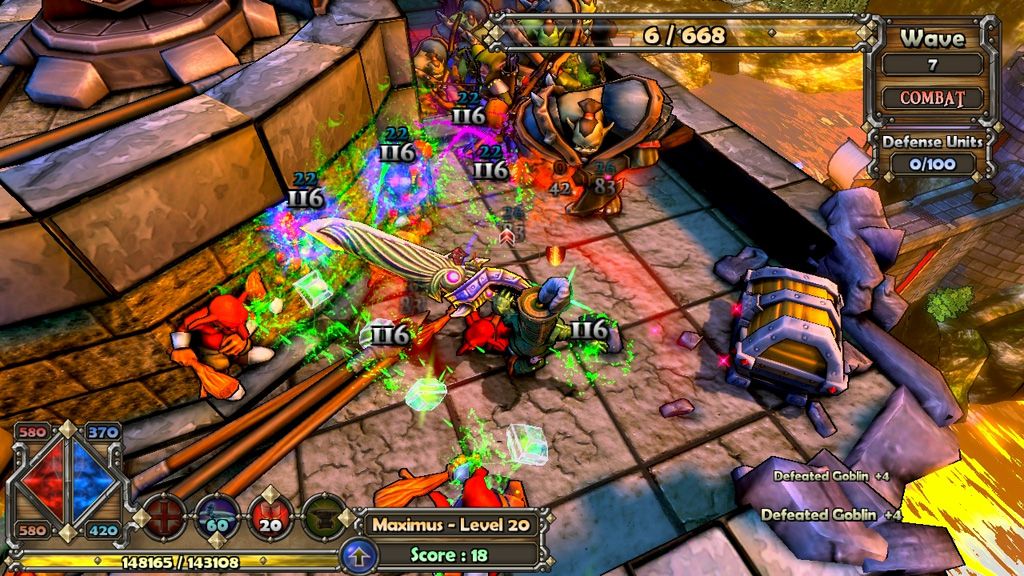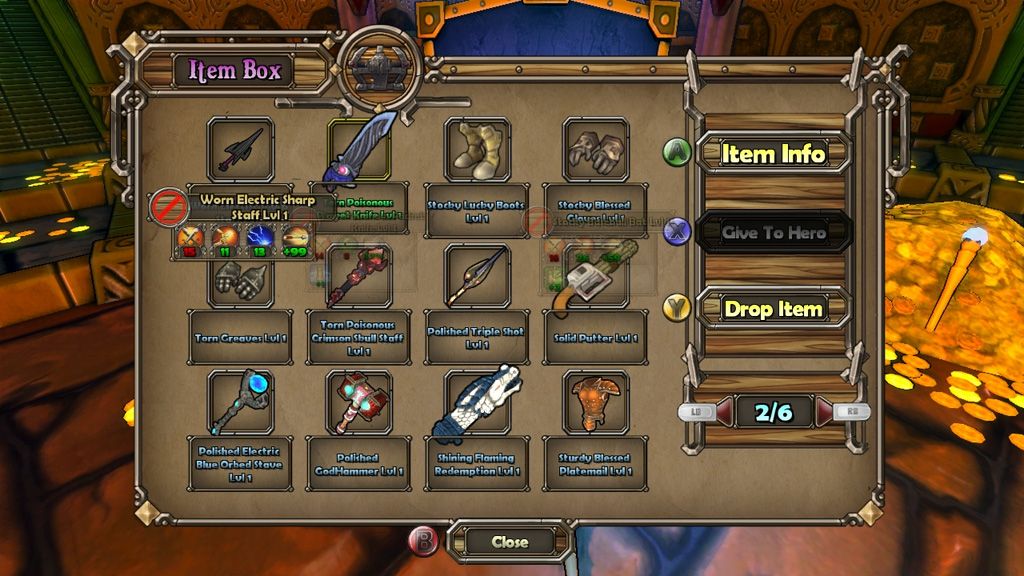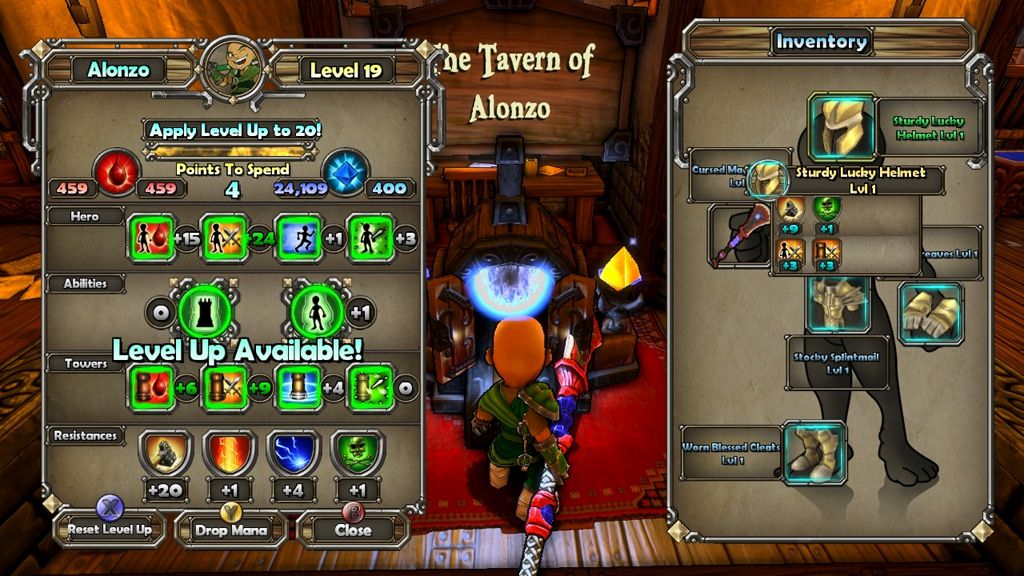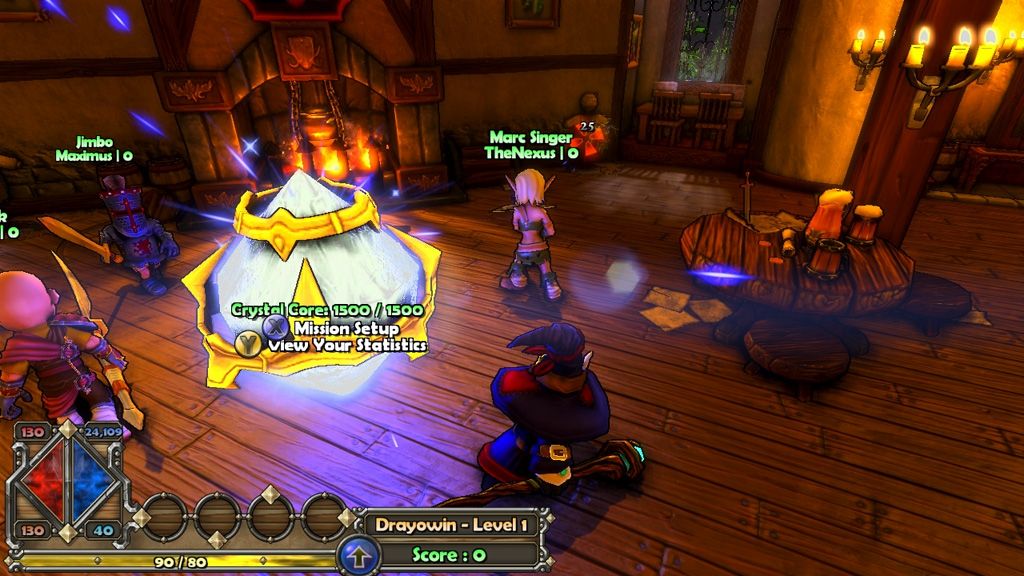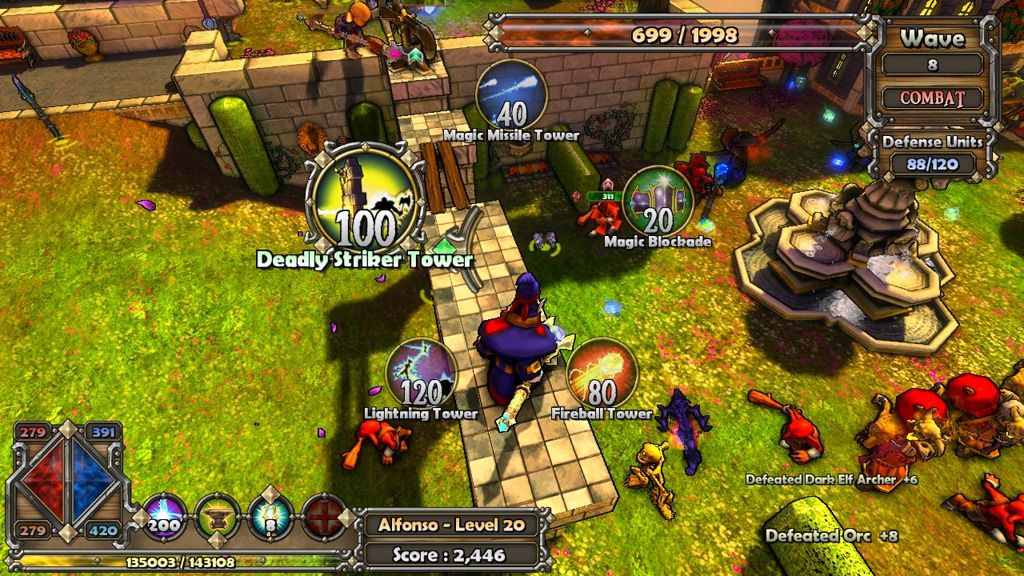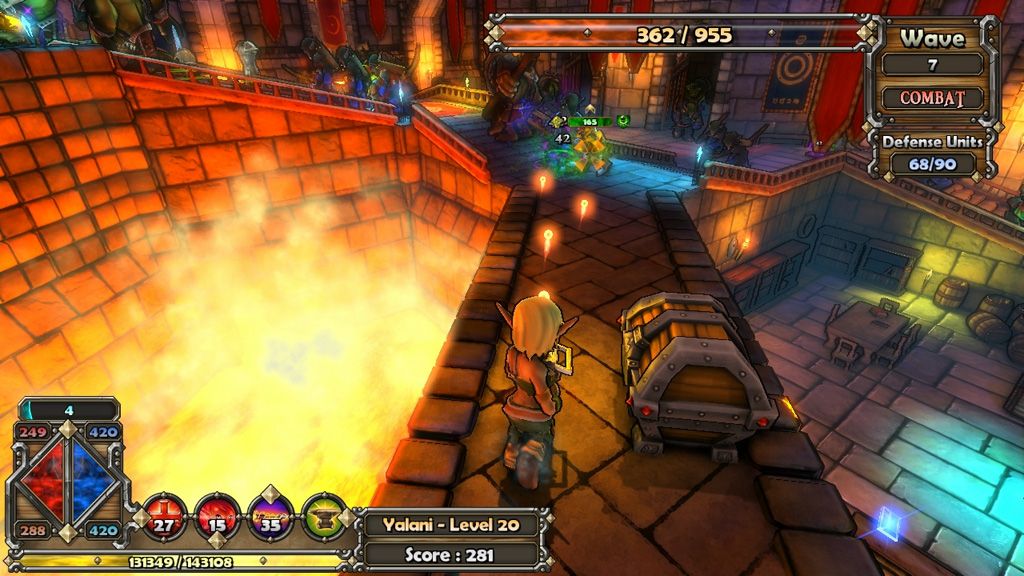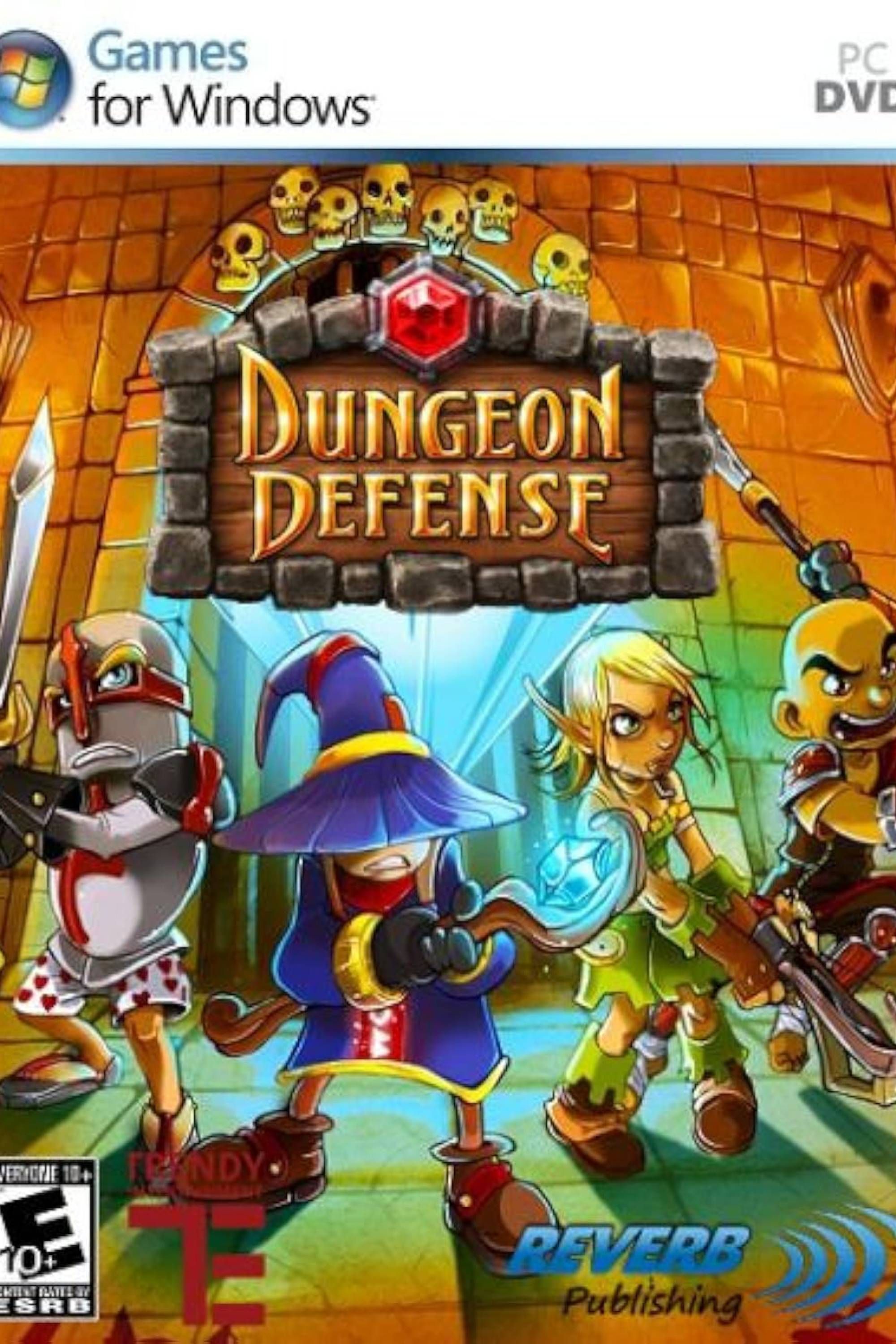I’ve had my eye on Dungeon Defendersfor a long while and, while I’m not a huge fan of tower defense games, I do like RPGs, and this title gives that genre more than enough love to go around.In a way, it seems like the core principle of the game - defending - takes a backseat to the meatier, deeper and, in my opinion, more fun RPG elements that seem to encompass it. But, before I get too much into what I do and don’t like about this particular title, it all starts with the story...
You see, quite a while ago great heroes banished evil into these huge crystals, called eternia crystals. Why you would store your enemies inside gorgeous crystals, one can only guess. But they did. Then, for some reason, they all left. That’s right, they packed up and skipped town, leaving their young ones around to defend these crystals. So now, you’re tasked, as one of four different classes representing the younger generation of these heroes, to protect the eternia crystals from being broken by hordes of enemies, thus letting out the evil that was shut inside them all those years ago. That’s good parenting, right there - leaving your kids to clean up the mess you made. Oh, wait, that’s like real life...Moving on, as mentioned, Dungeon Defenders seems to combine a lot of different genres into one massive game that can quite literally take up dozens and dozens of hours of your life. There are obviously aspects of tower defense games and RPGs here, but also hack-and-slash and beat-em-up titles, as well. Toss in a dash of strategy, some action elements, mix everything together, and you have a great game.
Before I get into the heart of the game - the building of defenses and fighting - I want to talk a little about the soul. I really, really adore the stylistic art style the game uses. It is colorful, imaginative and eye-catching. It screams high fantasy, but has a quirkiness and warmth to it, as well. It invites you in to its embrace, makes you want to play and grabs hold of you so hard that you can’t let go. I realize there are some who will play this for the action and strategy aspects, but I’m a big believer in the philosophy that those things wouldn’t be half as fun as they are without an alluring world to surround it all.
There are four classes to play - the apprentice, the squire, the huntress and the monk. Each of these, naturally, have their pros and cons. My favorite two, however, were the huntress and the apprentice. The apprentice reminded me of Vivi from Final Fantasy IX, and he is badass, so it was cool to play a character like that.
Each class has their own defense and abilities in combat. Just to take my two favorites as examples - the apprentice focuses on magical weapons and barriers, while the huntress has traps that she lays down to various degrees of success when enemies walk on top of them. They also have different personal attacks and defense abilities. While the monk can be very forceful in combat, he is also very weak. The squire has a lot of defense and decent combat strength, but can’t attack from a distance.
I had a lot of fun with the ranged attackers hopping up on walls to fire down on enemies, picking them off as they strained to get through the defenses I had set up. Perhaps that’s one of the things that drew me to those two classes in the first place? Well, that and the Vivi complex I have.
Delving into the actual heart of the game now. Basically, when you start a level, you’re deposited in a dungeon that you have to defend (imagine that). The first level acts as a pretty solid tutorial to the rest of the game, so you really shouldn’t be at a loss of what to do after you play through it. There are two major phases in each wave, and each dungeon level in the main story has a certain number of waves that you have to fight through.
Before each wave of enemies, you’re presented with free run of the entire level. This is the build phase, where you can set your defenses, upgrade your characters, open treasure chests and all that jazz. You’re given the amount and type of enemies that will be pouring out of the various doors (which will open during the battle phase), so you can lay out your defenses accordingly, espeding mana (the game’s currency) to do so. I tended to focus more on keeping the enemies a long ways away from the eternia crystal, so I would set up barriers and traps closer to the doors than to the crystal. However, it’s never wise to let your crystal go completely undefened, either.
Regardless, as you move through the waves of enemies, any defenses that survive that wave remain, so you don’t have to rebuild them. You will, however, get to repair or upgrade them during the next build phase. Trust me, if you don’t repair, you’re in for a world of hurt, as they will likely drop the next time huge ogres go up against it. So, it’s pertinent to go around repairing all your previous defenses before placing new ones, keeping in mind that the number of enemies rises exponentially in each successive wave.
The battle phase is where all the action happens, and you get to see exactly how well you did in placing your defenses. Letting your defenses to the work is only half the battle, however. You may want to help yourself, and each character has their own ways of attacking, with different results.
I found that the auto-targetting was kind of hit or miss, as sometimes I could be standing practically right in front of an enemy and be shooting off into thin air somewhere. Other times, though, it did a great job of keeping locked onto enemies as I ran around trying to keep out of harms way. With the melee classes, like the squire, things were a bit less complicated, as you just hop in the fray and go at it. I had to be a bit more selective with what I attacked and how I went about it with the apprentice and the huntress.
Enemies, when killed, can drop both gear and mana for you to stockpile. If gear has a green box around it, it’s an upgrade and you can equip it immediately. If it has a red box, it isn’t an upgrade and you can send it off to your item locker to either use on one of your other characters or to sell later.
Now, there is a great co-op aspect to these two phases, as well, which I’ll talk about here since, I suppose, this is where it belongs. Basically the exact same things happen in each phase when you’re playing co-op, except obviously your co-op partners play a different character than you do. You can coordinate defense placement, enemy management during the battle phase and all sorts of stuff. As far as how the game plays out in each dungeon, things are generally the same, except you can work together and, to be honest, things seem easier.
Multiplayer and co-op are also very, very much more chaotic. I played through the campaign mostly by myself, and, while it does get messy at times and can be quite difficult, nothing compared to the complete and utter chaos of multiplayer. In most instances I’m against that much of a mess, but in Dungeon Defenders it was actually fun, not just because of the fact that you’re playing with friends, but a lot of it has to do with seeing how the pros and cons of the various classes sort of balance each other out when you have someone else there playing with you.
In either case, as you defeat enemies you level your character up, which means you can place points into beefing them up in various ways. You have to choose how many points to put into which aspects of character development. Do you want to improve the character themselves and their attacks and health? Do you want to improve the defenses the character can drop? Increase their elemental resistance to something? It’s all up to you. And, luckily, you can respec yourself if you screw your character up so bad that you can’t stand it (although this is quite expensive).
There’s also a loot-whoring aspect to the game, as well. Enemies can drop gear, and gear can show up in the treasure chests that spawn between waves. The cool thing here is that those chests and enemies only drop loot for the character you’re playing. So, if you’re using the huntress and pop open a chest, you aren’t going to get a sword, because she uses bows, not swords. However, the downside is that there seems to be so many variations of weapons and gear out there that you really can’t trust the “green/red” boxes to tell you which gear is going to be better for you. I mean, you can if you just want to handle it quickly, and this will benefit some people who dislike to micro-manage their characters. But, at the same time, if you like that aspect of RPGs, you will benefit by handling things yourself.
If you think setting up defences and battling it out toe-to-toe with ogres and their ilk is all there is to do, you’re vastly mistaken. Between levels and multiplayer matches, you and your buddies can hang out in the tavern, where there are various services - including an item shop where you can buy and sell just about everything you need.
What’s kind of cool about the shop is that it adapts to how far along you are in the game, and the shopkeeper gets new items and such for you to purchase as you progress. Some of the best items, however, are rather expensive. Some aren’t even items at all. For example, you can purchase a respec for your character for 100,000 mana (which is a lot of cash at the beginning of the game). You can also purchase experience boosts that help you out during the battle phase and help level up your character faster.
You'll also get access to Challenge Mode in each dungeon that you clear, which sets a specific objective in front of you. For example, one of the challenges from the first dungeon is to clear it without using any defense towers. So, you'd have to attack and defend mostly with just your character.
Now, let’s get back to what I said earlier about the RPG aspects of the game seeming to outweigh the fact that, at its core, this is a tower defense game. This isn’t a bad thing; you know me, I’m an RPG maniac. I think it actually makes the game better. This is really a game for RPG fans, not tower defense fans, and that’s what attracted me in the first place.
There are, however, a few downsides. The targeting, which I already mentioned, is rather wonky and inconsistent. The camera is also a huge issue. There are four different camera angles which you can toggle through. Three of them are very similar above-character views, just at various degrees of distance from your character. The last angle is an over-the-shoulder camera of your character, which it automatically swaps to when the battle phase starts.
My issue is two-fold. First, you can’t adjust between normal and inverted camera controls. That drives me insane. Secondly, three of those camera angles don't give you a very good view of your surroundings. You can see what is nearby you, but you can’t look off in the distance to see if there’s something you need to personally handle. The annoyance here is mitigated a bit by the on-screen warnings when defenses fall and when enemies finally get to your eternia crystal, but it still doesn’t excuse the fact that the camera is kind of rough around the edges. The camera view that you can switch to that is behind your character is more helpful, because you can see stuff going on in the distance, but then, to me, it was harder to keep track and deal with what was right in front of you. As far as the camera goes, there was no happy middle ground, so to speak.
I also do think the difficulty curve is too high, especially if you're solo. After the tutorial stage, you seriously are thrown into the fire. I’m not joking, either. The second stage is rough, and it only goes downhill from there. For experienced players, perhaps they can handle it, but for newer players coming in for the first time, some degree of depression might set in when they continually get ransacked by the final wave in the second dungeon (as happened to me - it took me five tries to get through it). There are, however, various difficulty modes. Perhaps easy is easier? I don’t know, I didn’t play on easy.
That difficulty issue leads directly into what I see as one of the biggest downsides to this whole title, and that is that it was obviously built as a co-op game. To be perfectly honest, if the single-player aspect was removed, this would still be a perfectly great game, and as you play through it you start to wonder why it is even there in the first place. Also, if that was gone, I wouldn't have to complain about the single-player issues in this review!
Now, I have heard the developer say that co-op is where the game gets really fun and is really the way to play. That being said, there is a single player, and making things excruciatingly difficult when you play alone as opposed to when playing with friends doesn’t really make for a good faith relationship, to be quite honest. I played a mix of solo and co-op, but most of my solo play was toward the beginning when I was just getting my bearings. If I actually had to play this game entirely solo, I probably would have broken a few controllers, and those things aren't cheap!
This is kind of magnified because each character progresses independently, as well. As I mentioned, I preferred the apprentice and the huntress, which meant my squire and monk fell behind. So while my favorite two classes might be ready for later missions, the other two were far from prepared. This is, of course, fine if you co-op through the whole thing, as everyone can play what they want and work together as a team. But if you’re going at it solo, things aren’t so peachy (and, let’s face it, not everyone can or wants to play co-op all the time).
I think things would have been much nicer if the difficulty was adjusted down for those who wish to solo - because going that route you can still find quite an enjoyable experience. I just kind of got the feeling that the developers were saying basically “go co-op or go home”. I know that isn’t what was intended, but it is the way some things came across to me.
Overall though, Dungeon Defenders is a wonderful accomplishment by Trendy Entertainment. I highly appreciate the art direction, as it pulls you into the game. Let’s face it, the art style is one of the first things that hits you about any game, so if that’s good, you’re going to come back for more. The gameplay is excellent, aside from a few issues, and the RPG aspects are deep and rewarding.
If the difficulty and solo experience were more fine tuned, this would probably be one of the best smaller titles of the year, but I do really think those aspects put a damper on things, and if you’re thinking of playing mostly solo, you should be a bit wary. But, Dungeon Defenders is packed full of content, replay value and hours upon hours of strategic, hack-and-slash fun, especially if you’re playing with friends. For $15 it’s certainly worth it for both the eye-pleasing visuals and the overall great co-op experience.

